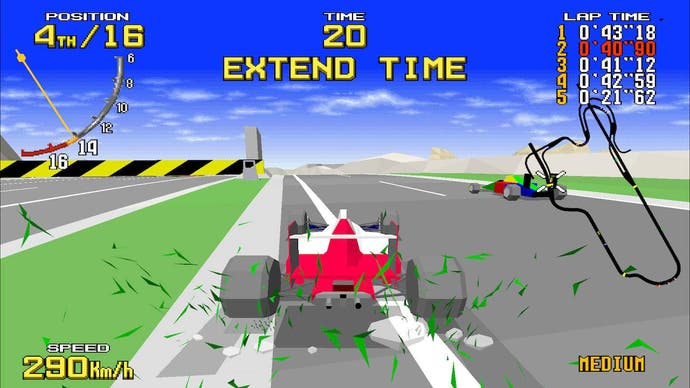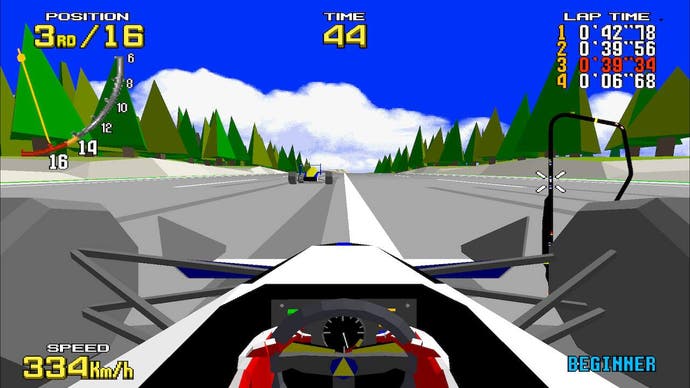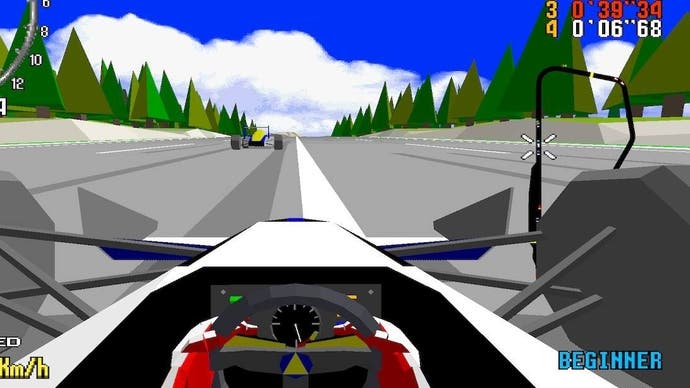The Switch's latest Sega Ages entry puts an old classic up for reassessment
Virtua assistant.
A funny little game, is dear Virtua Racing. You're not likely to find anyone proclaiming it as the best of Sega's 90s racers - it doesn't have the style and attitude of a Daytona USA or Scud Race, nor the poise or finesse of a Sega Rally or F355 Challenge - though maybe its greatest claim to fame is being the most important. Virtua Racing was a significant strike in the arms race between Sega and Namco that defined arcade racing in the 90s, and the start of a run of iconic games that stand as a golden era for the genre. It's where AM2's 3D style was forged, in the blue skies and green hills of Virtua Racing's three tracks, or in the stabs of tight funk from composers Koichi Namiki and Takenobu Mitsuyoshi.
And it's where you can first mark out the unmistakable rhythms of Toshihiro Nagoshi, working here as chief designer under Yu Suzuki. There's a music to Nagoshi's racing designs, from the sinewy guitar solos of F-Zero GX through to the out and out rawk of Daytona USA, and there's a nice languid tune to be found in Virtua Racing, its tracks unfurling to a distinctive beat of their own. I'll admit to never having had much time for this particular game, but what a delight it's been to get reacquainted with M2's brilliant Switch port, where that rhythm has a new fidelity; it's at its best, I think, in Bay Bridge, where a rolling uphill switchback is resolved with a quick chicane marked out by a concrete wall. Get it timed perfectly and your rear left kicks up a plume of polygonal grass. It feels fantastic.

More fantastic than I ever remember it feeling, really - maybe it's down to a few nips and tucks to the handling model (which is here available in 'normal' mode as well as 'arcade' mode, where it all begins to feel a bit more slippery), but this version of Virtua Racing has had me reassess its position in Sega's racing heritage. There's something to be said of the handling, as inconsistent as it is across the game's four views, which translates something of the grip of a winged open-wheeled racer, that downforce being brilliantly illustrated in the aggressively overstated lean of a cornering car as it pushes outwards on its suspension. It's about picking braking points and engaging in a little split-second trigonometry as you seek the perfect line. It's all quite satisfying.
And it all looks splendid, too. Virtua Racing's place in history has more traditionally been about its position at the forefront of Sega's push to 3D, and as the first game on the company's Model 1 hardware. Sega were playing catch-up, with Namco's splendid Winning Run, working off the System 21 board, setting the standard when it launched in 1988. That was allegedly pushing a mere 60,000 polygons per second, though - Sega's Virtua Racing could boast 180,000.

Which probably goes some way to explaining the shock to the system felt by those laying eyes on Virtua Racing for the first time in a 1992 arcade. This thing looked ridiculous, with weapons-grade technology (although Lockheed Martin weren't to be involved until the Model 2 board, of course) bringing to life a characteristically colourful take on racing. What's perhaps more impressive is it still has the power to shock today - thanks to the upscaling and general care taken in M2's port, which doubles the frame-rate along the way to a smooth 60fps, but also thanks to the cleanliness of the original's aesthetic. The lines are so clear-cut that the 3D feels tangible, presenting a world you feel you could reach into just so that you might prick a finger on all those sharp angles.
All of which makes the new version of Virtua Racing for Switch doubly enjoyable. Here's a classic not just dredged up but lovingly restored, allowing players to see it in a whole new light and reassess its importance. A funny little game, this Virtua Racing, but a damn fine one too, it turns out.

